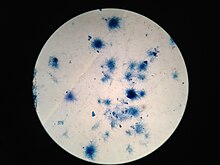Saccharopolyspora erythraea
| Saccharopolyspora erythraea | |
|---|---|

| |
| Scientific classification | |
| Domain: | Bacteria |
| Phylum: | Actinomycetota |
| Class: | Actinomycetia |
| Order: | Pseudonocardiales |
| Family: | Pseudonocardiaceae |
| Genus: | Saccharopolyspora |
| Species: | S. erythraea
|
| Binomial name | |
| Saccharopolyspora erythraea (Waksman 1923) Labeda 1987
| |
| Synonyms[1] | |
| |
Saccharopolyspora erythraea is a species of actinomycete bacteria within the genus Saccharopolyspora.
Saccharopolyspora erythraea produces the macrolide antibiotic erythromycin.[2] Cytochrome P450 eryF (CYP107A1) originally from the bacterium is responsible for the biosynthesis of the antibiotic by C6-hydroxylation of the macrolide 6-deoxyerythronolide B.[3][4]
Small non-coding RNAs have been suggested to be involved in regulation of the secondary metabolite biosynthesis.[5] It has been tested in simulations of space. It likes sugar and has many spores. S. erythraea was mostly found in soil in the Philippines. All of its uses derive from erythromycin, which was discovered in 1952. Erythromycin is used to prevent and aid infections in several different parts of the human body, including respiratory tract infections, skin infections, diphtheria, intestinal amebiasis, acute pelvic inflammatory disease, Legionnaire's disease, pertussis, and syphilis. Erythromycin is an antibiotic. It's often used to treat chest infections, such as pneumonia, skin conditions, acne and rosacea, dental abscesses, and sexually transmitted infections. In youth, erythromycin is widely used to treat ear infections and chest infections.
References[edit]
- ^ Labeda, David P. (1987-01-01). "Transfer of the Type Strain of Streptomyces erythraeus (Waksman 1923) Waksman and Henrici 1948 to the Genus Saccharopolyspora Lacey and Goodfellow 1975 as Saccharopolyspora erythraea sp. nov., and Designation of a Neotype Strain for Streptomyces erythraeus". International Journal of Systematic Bacteriology. 37 (1): 19. doi:10.1099/00207713-37-1-19.
- ^ Oliynyk, Markiyan; Samborskyy, Markiyan; Lester, John B.; Mironenko, Tatiana; Scott, Nataliya; Dickens, Shilo; Haydock, Stephen F.; Leadlay, Peter F. (2007). "Complete genome sequence of the erythromycin-producing bacterium : Saccharopolyspora erythraea: NRRL23338". Nature Biotechnology. 25 (4): 447–453. doi:10.1038/nbt1297. PMID 17369815.
- ^ Cupp-Vickery, JR; Poulos, TL (February 1995). "Structure of cytochrome P450eryF involved in erythromycin biosynthesis". Nature Structural Biology. 2 (2): 144–53. doi:10.1038/nsb0295-144. PMID 7749919. S2CID 22536232.
- ^ Harris, DL (20 September 2002). "Oxidation and electronic state dependence of proton transfer in the enzymatic cycle of cytochrome P450 eryF". Journal of Inorganic Biochemistry. 91 (4): 568–85. doi:10.1016/s0162-0134(02)00477-4. PMID 12237223.
- ^ Liu, Wei-Bing; Shi, Yang; Yao, Li-Li; Zhou, Ying; Ye, Bang-Ce (2013-01-01). "Prediction and characterization of small non-coding RNAs related to secondary metabolites in Saccharopolyspora erythraea". PLOS ONE. 8 (11): e80676. Bibcode:2013PLoSO...880676L. doi:10.1371/journal.pone.0080676. ISSN 1932-6203. PMC 3827479. PMID 24236194.
External links[edit]
